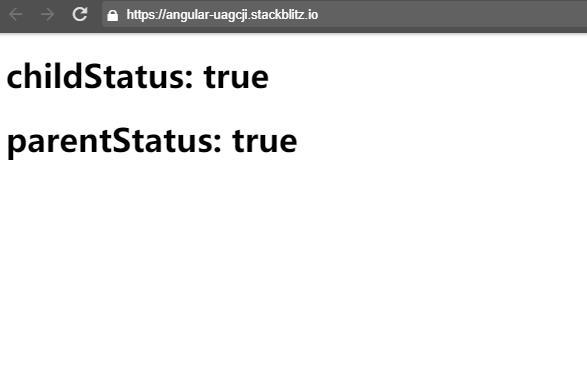Angular自定义组件实现数据双向数据绑定
Posted 前端设计与php开发
tags:
篇首语:本文由小常识网(cha138.com)小编为大家整理,主要介绍了Angular自定义组件实现数据双向数据绑定相关的知识,希望对你有一定的参考价值。
学过Angular的同学都知道,输入框通过[(ngModel)]实现双向数据绑定,那么自定义组件能不能实现双向数据绑定呢?答案是肯定的。
Angular中,我们常常需要通过方括号[]和圆括号()实现组件间的交互:
那么在[]和()的基础上,如何实现组件的双向数据绑定?
例子如下。
子组件:
<!--testDataBinding.component.html--><h1>childStatus: {{childStatus}}</h1>//testDataBinding.component.tsexport class TestDataBindingComponent implements OnInit{
@Input() childStatus; @Output() childStatusChange = new EventEmitter();
ngOnInit(){
setTimeout(()=>{ this.childStatus = false; this.childStatusChange.emit(this.childStatus);
},5000);
}
}注意这里的写法,这是关键所在,输出属性前半部分必须与输入属性相同,输入属性可以随意取名,输出属性需在输入属性基础上加上Change,比如你的输入属性是myData,那么输出属性就必须是myDataChange。
父组件:
<!--app.component.html--><test-binding [(childStatus)]="parentStatus"></test-binding><h1>parentStatus: {{parentStatus}}</h1>//app.component.tsimport { Component,OnInit } from '@angular/core';@Component({ selector: 'my-app', templateUrl: './app.component.html', styleUrls: ['./app.component.css']
})
export class AppComponent implements OnInit{ parentStatus: boolean = true;
ngOnInit(){
setTimeout(()=>{ this.parentStatus = true;
},10000);
}
}在父组件我们初始化parentStatus为true,并把它传到子组件TestDataBindingComponent。
在子组件里,5秒后我们把childStatus设为false,看它能不能传到父组件。再过5秒,我们在父组件将parentStatus设为true,看它能不能传到子组件。

事实证明,子组件值变化后,父组件的值也跟着变化;父组件值变化后子组件的值也跟着变了!
我们实现了双向绑定!
查看本文代码和效果,可点击这里。
【快快关注我吧】
以上是关于Angular自定义组件实现数据双向数据绑定的主要内容,如果未能解决你的问题,请参考以下文章